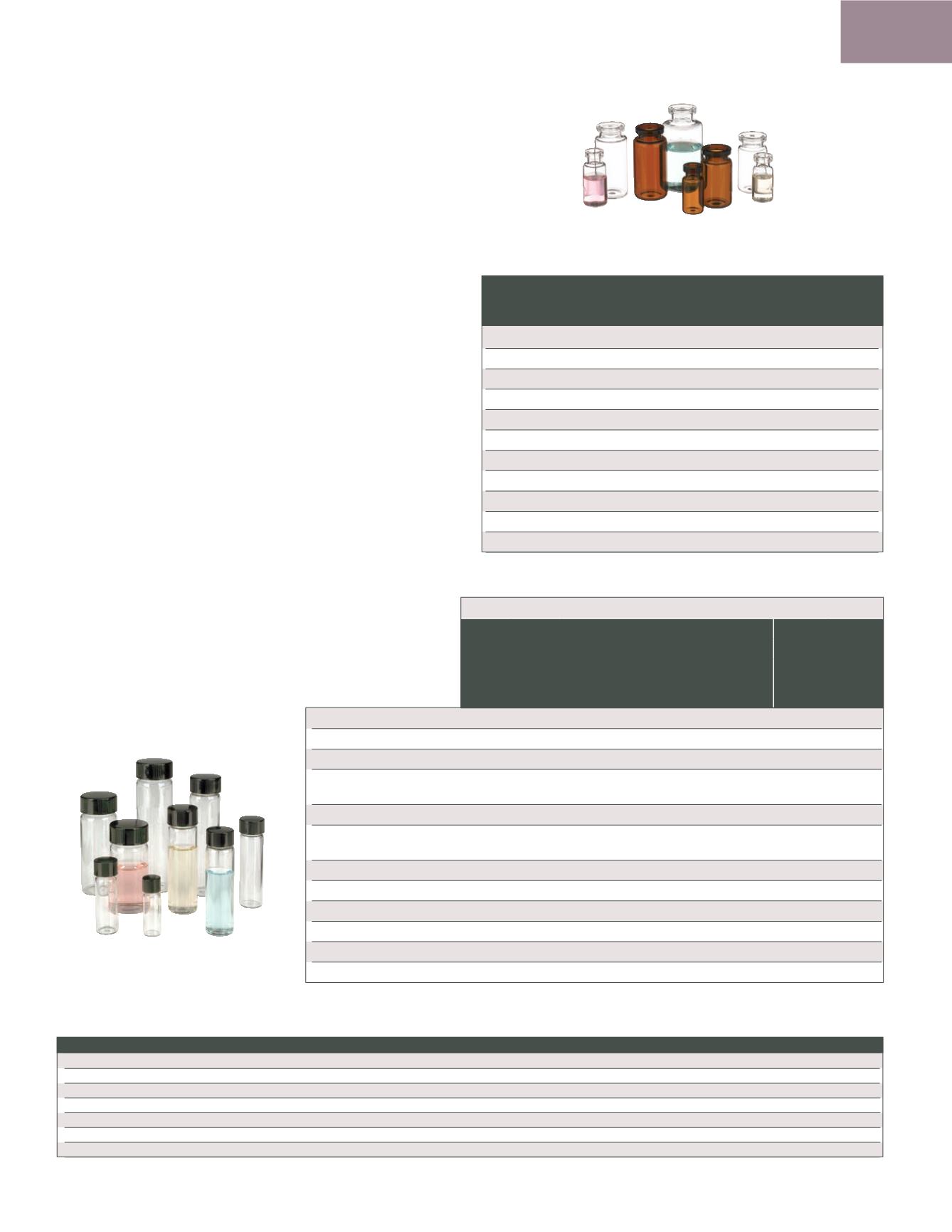

WHEATON
800.225.1437 (U.S. & Canada Only) | 856.825.1100 | 856.825.1368 (F) |
www.wheaton.comTubular Sample Vials
Serum Vials
> 176
Technical Data, Glass
Table 5. Typical Properties of WHEATON Glass
Borosilicate
Soda-Lime
“180”
“200”
“300”
“320”
“400”
“500”
“800”
“900”
Tubing
Vial
Clear
Tubing
Vial
Clear
Tubing
Vial
Clear
Tubing
Vial
Amber
Molded
Container
Clear
Molded
Container
Amber
Molded
Container
Clear
Molded
Container
Amber
Strain Point °C
510 505 525 510 520 505 510 496
Annealing Point °C
560 560 570 560 560 540 548 536
Softening Point °C
821 820 785 770 735 730 729 713
Linear Coefficient of
Expansion (0-300°C) x 10
-7
33 33 55 55 63 62 88 91
Density g/cm3
2.23 2.22 2.33 2.42 2.44 2.46 2.48 2.50
ASTM E-438 Glass Type
I
I I — — — — —
& Class
A A B — — — — —
USP Powered Glass <660>
Type I Type I Type I Type I Type I Type I Type III Type III
USP Light Transmission <671>
— — — Yes — Yes — Yes
USP Arsenic <211>
Yes Yes Yes Yes Yes Yes Yes Yes
EP Glass Grains (Test B) 3.2.1
Type I Type I Type I Type I Type I Type I Type III Type III
EP Spectral Transmission 3.2.1
— — — Yes — Yes —
Yes
EP Arsenic 3.2.1
Yes Yes Yes Yes Yes Yes Yes Yes
USP= U.S. Pharmacopeia, EP= European Pharmacopeia
Glass Types
The glass products in this catalog are made from many different glass formulations.
Following are brief definitions of these glass types and descriptions of their characteristics.
180 Glass:
An exceptionally clear borosilicate glass of high chemical durability, which has
been especially formulated for the lowest background count. Great care has been taken
to select only those ingredients for the batch that would not cause unwanted background
count or color. Potassium as a separate element has been excluded from the batch to
minimize K40. Special controls assure high quality and batch-to-batch uniformity. This
glass is only available as a tubing vial.
200 Glass:
Also referred to as 33 expansion low extractable borosilicate glass, is a clear
borosilicate glass with exceptional thermal endurance that meets the requirements for
ASTM E-438 Type I, Class A. This glass also meets USP Type I Powdered Glass, USP
Arsenic, EP Type I Glass Grains (Test B) and EP Arsenic as specified in the current revisions
of the U.S. Pharmacopeia and European Pharmacopeia. Most of our laboratory products
are made from this type of glass.
300 Glass:
A chemically resistant clear borosilicate glass that meets the requirements
for ASTM E-438 Type I, Class B. This glass also meets USP Type I Powdered Glass, USP
Arsenic, EP Type I Glass Grains (Test B), EP Arsenic as specified in the current revisions of
the U.S. Pharmacopeia and European Pharmacopeia.
320 Glass:
A similar composition to 300 Glass except amber color for light sensitive
applications. Meets UV light protection limits as specified in the current revisions of the
U.S. Pharmacopeia and European Pharmacopeia.
400 Glass:
A clear borosilicate glass that falls well within the limits for USP Type I
Powdered Glass, USP Arsenic, EP Type I Glass Grains (Test B) and EP Arsenic as specified
in the current revisions of the U.S. Pharmacopeia and European Pharmacopeia.
500 Glass:
Similar to the 400 Glass formulations except amber color for light sensitive
applications. Meets UV light protection limits as specified in the current revisions of the
U.S. Pharmacopeia and European Pharmacopeia.
800 Glass:
A superior soda-lime clear glass that meets the requirements for USP Type III
Powdered Glass, USP Arsenic, EP Type III Glass Grains (Test B) and EP Arsenic as specified
in the current revisions of the U.S. Pharmacopeia and European Pharmacopeia.
900 Glass:
Similar in formulation to 800 Glass except amber color for light sensitive
applications. Meets UV light protection limits as specified in the current revisions of the
U.S. Pharmacopeia and European Pharmacopeia.
Table 6. Typical Elemental Extraction Data of Some Glass Types (ppm)
USP Glass Type
Si Al Na K Ca Mg Fe Ba Zn
Ti
Type I Clear - Molded 1.3 <0.006 0.26 0.05 <0.02 <0.02 <0.015 <0.008 0.14 <0.005
Type III Clear - Molded 26 0.17 9.1 0.18 3.6
0.20 <0.01 <0.008 0.07 <0.005
Type I Amber - Molded 2.4
0.06 0.71 0.1 <0.02 <0.02 <0.015 <0.008 0.21
<0.005
Type III Amber - Molded 22 0.16 9.3 <0.03 3.4 0.23 0.016 <0.008 0.03
<0.005
Type I Clear - Tubular 4.8 <0.01 1.1 <0.03 0.13
0.07
<0.012 <0.008
<0.01 <0.005
Type I Amber - Tubular 7.4 0.17
1.8
0.45 <0.02
<0.02
<0.015 <0.008 0.23 <0.005
Blank- PE <0.05 <0.006 <0.01 0.048 <0.02 <0.02 <0.015 <0.08 <0.006 <0.005
Results after autoclave at 121°C for 60 minutes - high purity water in 20mL containers
Table 4. Typical Composition (%) of Some Glass Containers
“180” “200” “300” “320” “400” “500” “800” “900”
Forming
Tubing
Tubing Tubing Tubing Molded Molded Molded Molded
Process
Vial
Vial
Vial
Vial
Container Container Container Container
Si0
2
81
81
72
70
69 65.5 73
73
Al
2
O
3
2
2
7
6
5.5
6
2
2
Na
2
O+K
2
O
4
4
9
8
10
9
14 14.2
CaO+MgO
<0.2 <0.2 1
0.5 1.5 0.5 10.5 10
B
2
O
3
13
13
12
7
11
9
— 0.5
Fe
2
O
3
<0.1 <0.1 <0.1 1.5 <0.1
1 <0.05 0.3
BaO
— — <0.1
2
2.5 1.5
— —
ZnO
— — — — 0.5 0.5
— —
MnO
2
— — — — — 7
— —
TiO
2
— — — 5
— — — —
SO
3
— — — — — — 0.2
—
Glass Type
















